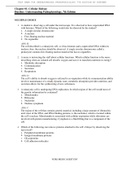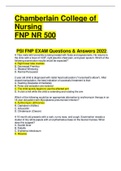Circular chromoso - Study guides, Class notes & Summaries
Looking for the best study guides, study notes and summaries about Circular chromoso? On this page you'll find 4 study documents about Circular chromoso.
All 4 results
Sort by

-
Cellular Biology
- Exam (elaborations) • 325 pages • 2021
-
- $10.49
- + learn more
1. A student is observing a cell under the microscope. It is observed to have supercoiled DNA with histones. Which of the following would also be observed by the student? a. A single circular chromosome b. A nucleus c. Free-floating nuclear material d. No organelles ANS: B The cell described is a eukaryotic cell, so it has histones and a supercoiled DNA within its nucleus; thus, the nucleus should be observed. A single circular chromosome called a prokaryote contains free-floating nuclear ...
QUESTIONS AND ANSWERS

-
Understanding Pathophysiology 7th Edition Test Bank
- Exam (elaborations) • 771 pages • 2021
-
- $13.49
- + learn more
1. A student is observing a cell under the microscope. It is observed to have supercoiled DNA with histones. Which of the following would also be observed by the student? a. A single circular chromosome b. A nucleus c. Free-floating nuclear material d. No organelles ANS: B The cell described is a eukaryotic cell, so it has histones and a supercoiled DNA within its nucleus; thus, the nucleus should be observed. A single circular chromosome is characteristic of prokaryotic cells, which do...

-
docx (9)patho.pdf-Exam (elaborations) NURS 3093-Pathophysiology Concepts of Disease (NURS 3093)
- Exam (elaborations) • 62 pages • 2021
-
- $12.49
- + learn more
hapter 1: Prokaryotes include cyanobacteria (blue-green algae), bacteria, and rickettsiae. Simple organization, no organelles, no nuclear membrane, lack of distinct nucleus, single, circular chromosome. Eukaryotic cells Animals, plants, protozoa, fungi, most algae, Membrane bound organelles multiple, structured chromosomes with supercoiled DNA, Well-defined nucleus, Ability to transport across outer membrane. *Cellular functions: Cells become specialized through cellular differentiation, or matu...

Do you wonder why so many students wear nice clothes, have money to spare and enjoy tons of free time? Well, they sell on Stuvia! Imagine your study notes being downloaded a dozen times for $15 each. Every. Single. Day. Discover all about earning on Stuvia



